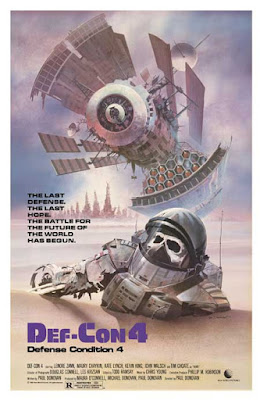Shock Treatment (1981)
This lesser-known semi-sequel to The
Rocky Horror Picture Show brings back some of the cast, along with the two
main characters, Brad and Janet (now played by Cliff De Young and Jessica Harper).
Jim Sharman returned to direct, and co-wrote the script with Richard O’Brien
(who also co-wrote the music and stars as Dr. Cosmo McKinley). The overall
soundtrack isn’t quite as catchy as its 1975 predecessor, but it does have its
moments (the title song is a standout).
If the previous movie represented the trials that newlyweds
face as they’re figuring each other out, then the follow-up explores the rut
some married couples end up in. Brad is stuck in an emotionally stagnant state,
committed to an asylum and heavily sedated for most of the film. Meanwhile, Janet
is seduced by fame, and a sleazy TV producer (also played by De Young). Not
unlike its predecessor, it’s an essentially plotless excuse for one musical
number after another. While Shock
Treatment isn’t without its share of loyal followers, it never gained the
same status as The Rocky Horror Picture
Show. It didn’t deserve to fade into obscurity, though. The film is worth
re-discovering for its commentary on our television-obsessed society, as well
as domestic malaise.
Rating: ***. Available on DVD
Maniac Cop (1988)
The title says it all. Maniac Cop delivers on its premise, with a deranged cop
(Robert Z’Dar) roaming the streets of Manhattan, killing innocent citizens. Directed
by William Lustig, from a script by Larry Cohen, Maniac Cop features B-movie superstars Tom Atkins and Bruce
Campbell. Atkins is especially good, playing the particular brand of world-weary
cop he was born to play (his laconic delivery and deadpan expressions are
priceless). It rises (a bit) above its schlock roots, thanks to some good
performances and a story that plays with the issue of blind questioning of
authority. Naturally, the open-ended conclusion leaves the door wide open for
the sequels.
Rating: ***. Available on Blu-ray, DVD and Hulu
Trancers (1985) Full
Moon Entertainment isn’t generally known for quality films, and this movie
might not dissuade you, but it’s not terrible, either. At least director
Charles Band and writers Danny Bilson and Paul De Meo attempted to try
something a little new. Tim Thomersen
stars as Jack Deth (yep, expect a bunch of jokes about his name) as a cop from
the future tracking down a dangerous crime lord named Whistler (Michael Stefani).
Whistler possesses the ability to make people bow to his will, transforming
into mindless zombies known as “trancers.” Deth travels back in time to present-day
Los Angeles (well, the mid ‘80s version, anyway) to catch the villain. During
his travails, he runs into his direct ancestor (a homeless former pro-baseball
player) and falls for a local girl (Helen Hunt in an early role). Don’t even
try to think about the time travel paradoxes. The filmmakers didn’t, and you
shouldn’t either. Fun fact: Look for
Frank Darabont’s name in the credits, in the Art Department.
Rating: **½. Available on Blu-ray, DVD and Hulu
Def-Con 4 (1985) In
a classic case of poster art promising far more than a film can deliver, Def-Con 4 sets the bar high but falls
short of the mark. Writer/director Paul Donovan’s movie starts out on a
promising note, but ultimately suffers from a lack of imagination or
interesting characters. Astronauts on a top secret space station armed with
nuclear missiles passively watch as World War III breaks out on earth. Due to a
technical glitch, they return to the planet’s surface to find a landscape devastated
by nuclear fallout. What’s left of society, at least in Nova Scotia where this
was filmed, has degenerated into roving cannibals and a paramilitary
organization. The last hope for humanity is a sailboat, headed to an uncertain
future. The movie suffers the fate of many would-be post-apocalyptic epics with
half-assed art direction, substituting heaps of junk for any attempt at
rendering a believable setting (Contrasted with the Mad Max films, where
everything had a cobbled-together look, but served a function). A must miss.
Rating: **. Available on DVD and Hulu
Fire and Ice (1983) A collaboration between Ralph Bakshi
and fantasy illustrator Frank Frazetta seems like a match made in heaven, but the
results are hampered by a pedestrian story and ho-hum animation that barely
rises above Saturday morning cartoon standards. In a land where men are men and
women are sex objects, an evil ice queen and her malevolent son threaten a
benevolent kingdom. Only a brave young warrior stands between the antagonists
and certain annihilation. None of the scantily clad characters rise above their
superficial, two-dimensional confines, or contribute anything we haven’t seen
many times before. In addition to the rampant sexism, Fire and Ice raises some disturbing implications by depicting the
queen’s evil minions as dark-skinned sub-humans who grunt in guttural tones. If
you’re not an adolescent male, you might consider looking elsewhere to scratch
your fantasy itch.
Rating: *½. Available on Blu-ray and DVD


























